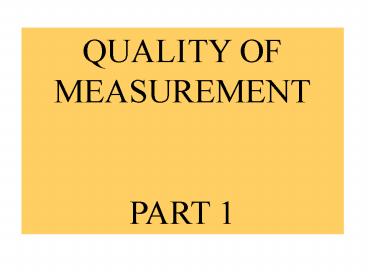QUALITY OF MEASUREMENT
1 / 13
Title: QUALITY OF MEASUREMENT
1
QUALITY OF MEASUREMENT PART 1
2
LIMITATIONS OF YOUR EQUIPMENT
3
RESOLUTION
SENSITIVITY
STABILITY
RESPONSE TIME
4
Find the height of the oceans to 1 cm from 1000
km..for the environmentalists, a Physics
problem.
5
Solution use a radar transmitter of 13 GHz. The
transmitter can be CALIBRATED using an atomic
clock, accurate to 1 part in 1012.
Work out the TIME PERIOD (time for one CYCLE) of
the transmission.
This is the time for a there and back pulsea
very STABLE piece of equipment!
6
f 1010 Hz
T 1/f 10-10 s 0.1 ns Resolution of
departure/arrival of signal is to within 1 cycle.
7
Resolution in DISTANCE Distance 106 m Change
in distance 10-2 m Resolution 1 in 108
Resolution in TIME Trip time 2 x 106 m/3 x 108
ms-1 10-2 s approx (2 way) Need a resolution in
trip time of 1 in 108 So time difference
resolution must be 10-2/108
10-10 s
0.1 ns
8
High RESOLUTION
High STABILITY
Low UNCERTAINTY
9
- Systematic errors
- Tracking these down makes your measurements
ACCURATE as well as PRECISE. - Pulse speed variation can be due to
- Electrons in atmosphere slowing pulse down /-
0.5 m - Water vapour in atmosphere /- 0.5 m
- O2 concentration affects pulse speed /- 2 m
- The BULGING Earth (it bulges at the equator).
- Winds, tides and atmospheric pressure.
10
RESOLUTION
The smallest change that your instrument can
detect.
For a scale, this is the value of the SMALLEST
SCALE DIVISION. For a digital readout, its the
value of one unit in the last digit.
e.g a microammeter with a range of 100 ?A with 50
divisions has a resolution of 2 ?A or 2 of the
range.
11
SENSITIVITY
This is the RATIO of the change of output to the
change of input. It refers to an instrument where
a scale is made to REPRESENT another range of
values.
e.g. a sensor measuring LIGHT uses a
VOLTMETER 6.0 V per lux. A CRO measuring p.d.
on a LINEAR scale on a screen 0.2 V per cm.
An AMPLIFIER can increase sensitivity.
12
STABILITY
A stable piece of equipment means that the repeat
readings are close to each other.
- Examples of things that can affect stability
- Pointers that stick slightly
- Bad electrical contacts
- A clamp that is not rigid
- Clumsy use of a micrometer.
13
RESPONSE TIME
The length of time a sensor takes to reach its
final reading following a sharp change in input.
Fast change sensors CRO necessary for HIGH
FREQUENCY fluctuations. LDR semi-conductor
Slow change sensors Light beam galvanometer
takes time for light beam to scan
scale. Ratemeter for radioactivity pointer shows
a steady AVERAGED rate.
Temperature sensors tend to be sluggish. Rapid
temperature fluctuations are hard to measure
reliably.































